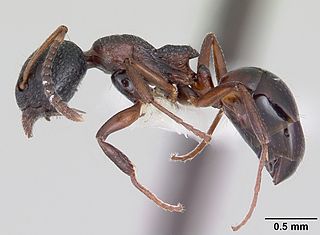
Dolichoderus is a genus of ants found worldwide.
Dolichoderus abruptus is a species of ant in the genus Dolichoderus. Described by Smith in 1858, the species is endemic to Bolivia, Brazil, Colombia, Ecuador and Peru.

Dolichoderus beccarii is a species of ant in the genus Dolichoderus. Described by Emery in 1887, the species is endemic to Borneo and Indonesia.
Dolichoderus coniger is a species of ant in the genus Dolichoderus. Described by Mayr in 1870, the species is endemic to Borneo.
Dolichoderus gibbus is a species of ant in the genus Dolichoderus. Described by Smith in 1861, the species is endemic to Indonesia.
Dolichoderus indrapurensis is a species of ant in the genus Dolichoderus. Described by Auguste-Henri Forel in 1912, the species is endemic to Borneo and Indonesia.

Dolichoderus kinabaluensis is a species of ant in the genus Dolichoderus. Described by Dill in 2002, the species is endemic to Borneo.
Dolichoderus lactarius is a species of ant in the genus Dolichoderus. Described by Smith in 1860, the species is endemic to Indonesia.
Dolichoderus magnipastor is a species of ant in the genus Dolichoderus. Described by Dill in 2002, the species is endemic to Borneo.
Dolichoderus maschwitzi is a species of ant in the genus Dolichoderus. Described by Dill in 2002, the species is endemic to Borneo.
Dolichoderus pastorulus is a species of ant in the genus Dolichoderus. Described by Dill in 2002, the species is endemic to Borneo.
Dolichoderus patens is a species of ant in the genus Dolichoderus. Described by Mayr in 1870, the species is endemic to Borneo.
Dolichoderus pilinomas is a species of ant in the genus Dolichoderus. Described by Dill in 2002, the species is endemic to Borneo.

Dolichoderus plagiatus is a species of ant in the genus Dolichoderus. It was described by Mayr in 1870.
Dolichoderus rugosus is a species of ant in the genus Dolichoderus. Described by Smith in 1858, the species is endemic to South America.
Dolichoderus semirugosus is a species of ant in the genus Dolichoderus. Described by Mayr in 1870, the species is endemic Borneo and Thailand.

Dolichoderus sulcaticeps is a species of ant in the genus Dolichoderus. Described by Mayr in 1870, the species is endemic to Borneo, Indonesia, Malaysia, Thailand and Vietnam.

Dolichoderus taprobanae is a species of ant in the genus Dolichoderus. Described by Smith in 1858, the species is endemic to Asia.

Dolichoderus thoracicus is a species of ant in the genus Dolichoderus. Described by Smith in 1860, the species is widespread in Asia.
Dolichoderus pinguis is an extinct species of formicid in the ant subfamily Dolichoderinae known from a fossil found in Asia. The species is one of a number in the genus described from fossils.







